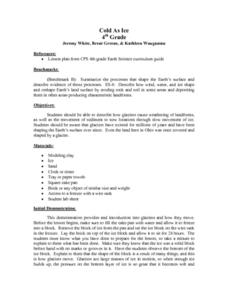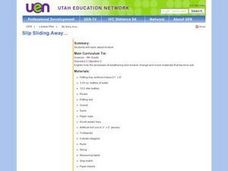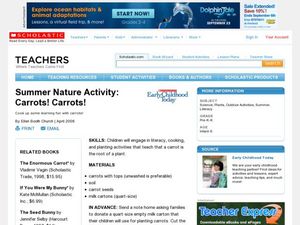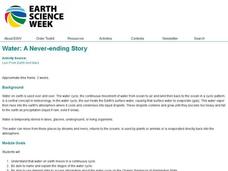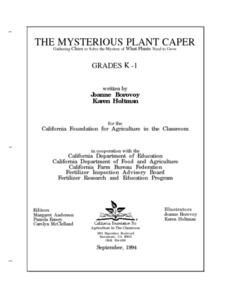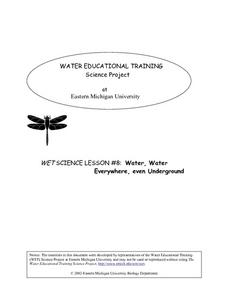Curated OER
Water Resource Engineering
Learners examine solubility and the significance of water. In this aqueous solution instructional activity students complete a lab activity on soil profiles.
Curated OER
Plant Transpiration
Students conduct various experiments to investigate plant transpiration. In this biology instructional activity, students explain how this process helps maintain the hydrologic cycle. They measure the rate of water loss in plants using a...
Curated OER
Rock Solid
Students investigate the three types of material stress related to rocks. They watch a PowerPoint Presentation, view an online animation of the three types of rock stress, identify the various types of rocks, answer true or false...
Curated OER
Forces in Action
Students investigate questions centered around force and motion by going through the scientific process and creating fair tests and experimentation. In this lesson about forces-in-action, students diagram their findings and explore other...
Alabama Learning Exchange
The Earth Has Many Layers
Students conduct an experiment. In this Earth's layers lesson, students learn about soil, sand and rock. They complete their own Jell-O Mountain and investigate the Earth's layers on-line.
Curated OER
Habitat Art: Florida Panthers
Students discover the lifestyles of a Florida Panther by investigating its habitat. In this wild animal instructional activity, students utilize the Internet to research the habits of a Panther and what their habitat is. Students...
Curated OER
Water Works
Young scholars investigate water use and what happens at a water treatment plant. They define and discuss key vocabulary terms, view a diagram of a water treatment plant, and conduct an experiment that simulates the water filtration...
Curated OER
Cold As Ice
Fourth graders investigate how glaciers cause the weathering of landforms. They observe a brick that has been placed on a frozen slab of ice, and discuss the results, comparing them to the movements of a glacier. In small groups, they...
Curated OER
Erosion: Slip Sliding Away
Fourth graders investigate the causes of erosion. Through several demonstrations including one using sugar cubes and warm water, they observe the effects of erosion. In groups, 4th graders conduct similar experiments and record their...
Curated OER
Micro-Organisms
Students investigate micro-organisms with an on line activity. In this micro-organism on line lesson plan, students identify bacteria, viruses and fungi projected onto a white board. Students work in groups and use a computer and an on...
Curated OER
Summer Nature Activity: Carrots! Carrots!
Students investigate reading, cooking, and planting activities that teach that a carrot is the root of a plant. In this early childhood science lesson, students explore the world around them as they read The Carrot Seed and complete the...
Curated OER
How We See Things
Students investigate how mirrors reflect light. In this reflection lesson, students draw the path of the light reflected from a mirror. Students construct a list of objects that are light sources.
Curated OER
Living or Non-Living
Students examine living and non-living things. In this life science instructional activity, students are given a group of objects and discuss if they are living or non-living. Students identify and list characteristics of living things.
Curated OER
Rice Farming
Third graders investigate how farmers get more rice from their land. In this farming instructional activity, 3rd graders discover things that farmers to do produce more rice. Students study photosynthesis and illustrate pictures about...
Curated OER
Water: A Neverending Story
Learners investigate the water cycle. In this water cycle science lesson, students participate in a series of activities that demonstrate evaporation, precipitation, and condensation. Learners describe their observations using water...
Curated OER
The Mysterious Plant Caper
Students investigate the basic parts of plant and that plants are living things which require water, air, light and nutrients for survival. They do this through a series of scientific experiements and multi-curricular hands-on activities.
Curated OER
Acid Rain
Students investigate acid rain. In this environmental lesson, students participate in an experiment using litmus paper and various liquids and then test the acidity of the liquids. Students identify reasons why acid is harmful to the...
Curated OER
Healthy Water!?
Students test water for its quality and record their information.In this water quality lesson, students investigate water for pH, macro invertebrates and identify its characteristics. Students complete worksheets on their data for their...
Curated OER
What Are the Layers of the Rain Forest?
Students investigate the different levels of the rain forest by comparing it to an apartment. In this ecology lesson, students practice using forest related vocabulary words and complete a vocabulary data sheet. Students create...
Curated OER
Disposing Garbage
Young scholars explore environmental cleanliness by completing a worksheet in class. For this waste management lesson, students identify the technological advances in society and how they increase waste production our planet is unable to...
Curated OER
Water, Water Everywhere, Even Underground
The "Engage" section of a wetlands lesson plan asks young ecologists to examine a wetlands poster. You can easily find one online and display it using a projector. Pupils immerse a piece of sandstone and a piece of granite in water to...
Curated OER
Beanie Baby
Students investigate the growing of beans by using a creative experiment. They plant and grow beans in a bag before transplanting them. The bean bag is checked several times a day and the data is recorded. The data is analyzed and...
Curated OER
Aquatic Investigations
Fifth graders investigate pond organisms, plant life, water temperatures, and changes that occur during the four seasons. They design scavenger hunts with the information collected about pond life. They read about the geology of the...
Curated OER
Investigating Monocots and Dicots
Students know about monocotyledons and dicotyledons. They explore the differences between the seed structure of the two by examining bean and corn seeds. They sprout seed to observe the differences in both of their growths.









